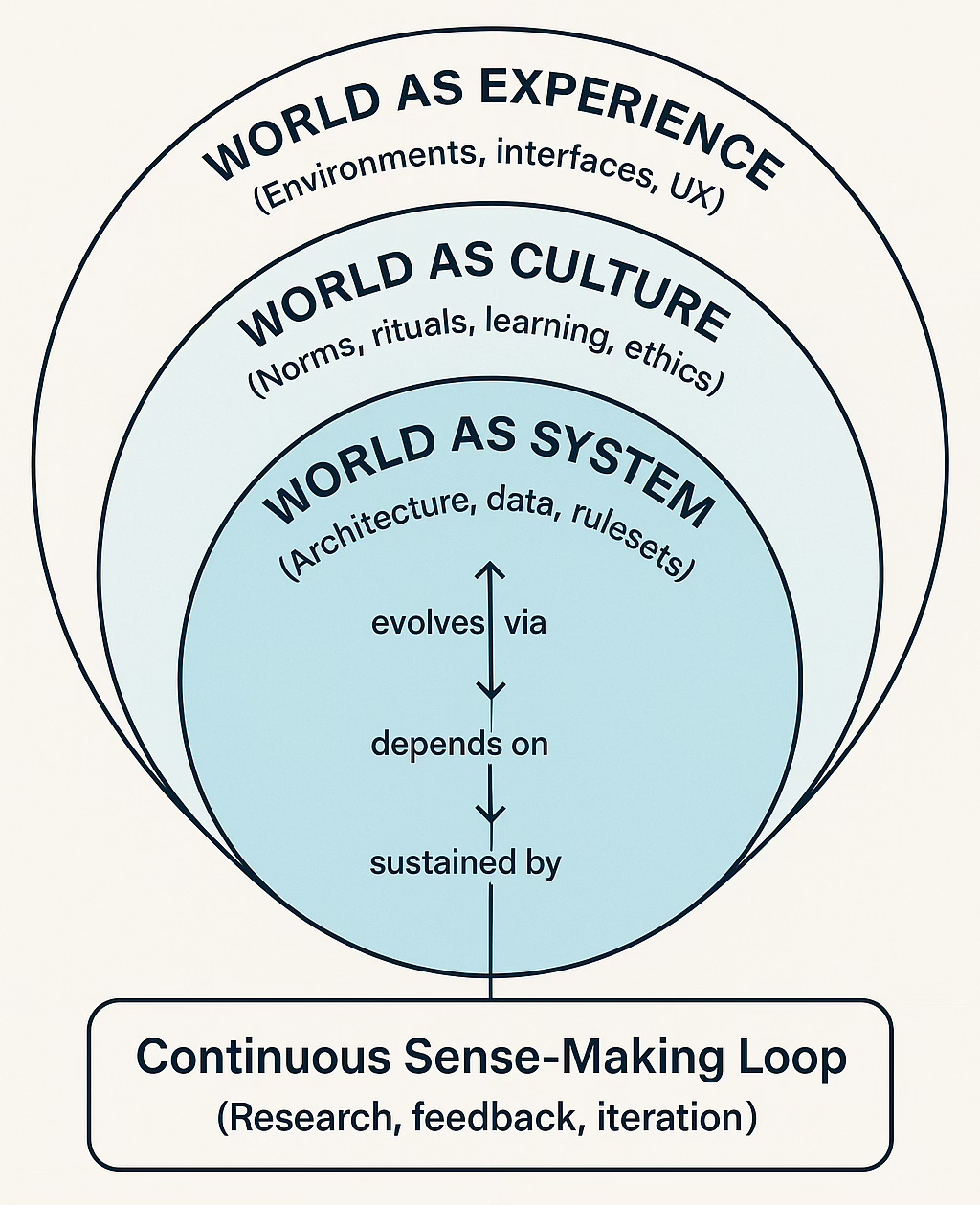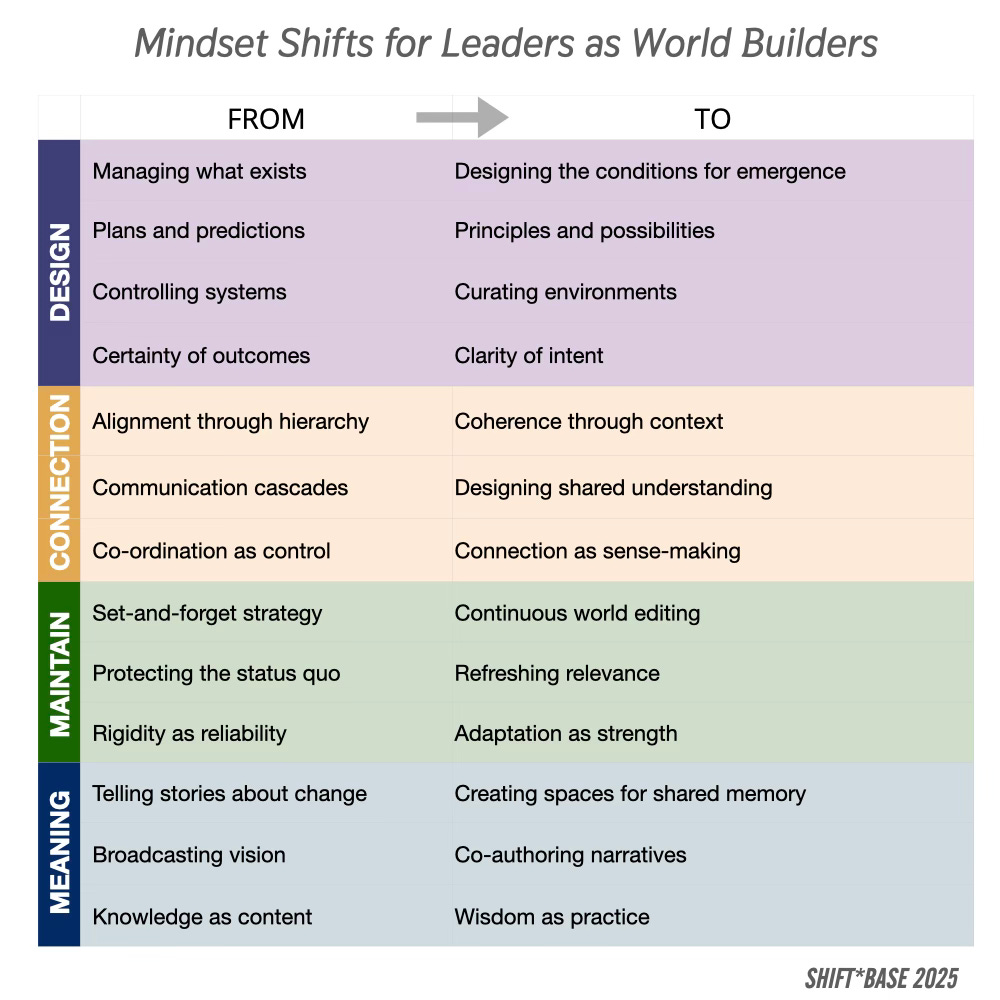A Leader’s Guide to World-Building in the AI-Augmented Enterprise
A leadership framework for world building, and key mindset shifts that open up a new way of thinking about the role of non-technical leaders in the AI-enhanced enterprise.
Last week, we mentioned the growing importance of world building in the context of readiness for agentic AI and smart automation / augmentation of work.
But what does this mean in practical terms for leaders who want to get the balance right between human and synthetic intelligence in the workplace, and how can this help create a more engaging and human experience of work?
It seems every leadership team is starting to talk about agents, copilots, and orchestration layers, but are perhaps not focusing enough about the readiness of the world they will be part of, which still largely operates on the basis of brittle manual processes, unspoken rules, and tacit coordination. Codification is partial, context is fragile, and leadership mindsets are still tuned to control, not coherence.
World-building is emerging as a key focus area for enterprise AI readiness, and an important area of modern leadership capability - and one that does not depend on deep technical knowledge.
We know that the most engaging stories, movies and designed experiences tend to create their own aesthetic, language, norms, rules and ‘feel’. The best video games go further by populating their worlds with AI-driven characters to help you and carry the story along (often called non-playing characters or NPCs), and games also typically use their own physics engine and rules to dictate things like gravity, movement speed and the behaviour of the physical environment.
But what are the organisational design equivalents of these techniques, and how can leaders begin thinking about using world building to adopt and embrace enterprise AI more effectively?
First, Why this Matters: the Context Gap
The more that agentic AI comes to the fore, the more enterprises begin to behave like open worlds rather than closed machines.
Agent platforms such as OpenAI’s AgentKit and Google’s Gemini Enterprise are quietly absorbing many of the co-ordination and monitoring tasks that once filled the time of middle management.
Context systems like reasoning banks, memory layers, and orchestration engines are linking intent, data, and decision logic across functions.
Learning agents are starting to interpret user behaviour, anticipate needs, and refine workflows dynamically.
The technical architecture is advancing fast, but the cultural architecture is not. Rules remain implicit, values are inconsistently applied, and organisational lore (the stories and lessons that give identity its depth) is often lost between systems.
We are building agent-ready infrastructure, but not yet designing the world those agents will be expected to operate within.
The result is predictable: technically powerful systems operating in context-poor environments, optimising locally while drifting strategically. Human teams feel disoriented; AI outputs lack coherence; leadership loses visibility of how meaning travels through the organisation.
We’re already seeing the early symptoms of this fracture.
Customer-support agents trained on narrow datasets, optimise for ticket closure speed but degrade overall satisfaction.
Marketing copilots generate on-brand assets that clash with local tone or ethical standards.
Internal chatbots answer accurately but without awareness of new strategic priorities.
Each system performs well in isolation, yet collectively, they erode coherence. Without meaningful context and connection, the technology struggles to move beyond the tactical layer.
Signals from the Edge
The earliest signs of world-building are already visible, not in theory decks, but in tools and systems emerging from the frontier of AI development.
Gemini Enterprise: Released by Google Cloud in October 2025, Gemini Enterprise moves beyond standalone productivity tools into a full agent orchestration platform. It includes a no-code workbench, pre-built agents, seamless connection to enterprise data, and a central governance framework for visualising, securing, and auditing agents.
Genie 3: From DeepMind, this “world model” marks a leap: it generates interactive, consistent virtual environments in real time, enabling agents to live inside persistent worlds rather than just execute isolated tasks.
AgentOps (and the broader AgentOps ecosystem): AgentOps represents the emerging discipline of agent-operations: observability, monitoring, governance, and lifecycle management of intelligent agents. Platforms like AgentOps provide real-time dashboards, traceability, and guardrails for multi-agent systems.
Human-level transitions in organisational practice: On the human side, forward-looking organisations are codifying team onboarding as narrative “world maps,” revisiting learning as persistent worlds, and treating organisational lore (decisions, turning-points, stories) as structured data for shared sense-making. These behavioural shifts are less visible in product announcements but are abundant in the field.
Across these signals, one pattern stands out. As intelligence spreads through systems, coherence becomes a leadership function. The job is no longer to optimise each component, as in the Taylorist model; it is to design the world that connects them.
Leadership as World Design
In the industrial era, leadership was about output management.
In the digital era, it became focused on platforms and systems management.
In the agentic era, leadership is evolving again, towards world design and stewardship.
Leaders are learning new techniques, but they also need to unlearn old practices. Instead of managing activity through plans, approvals, and control loops, their practices are moving towards curating minimal contracts, contextual rules, and shared narratives that make a hybrid human–machine environment coherent.
As AI takes on more of the visible, repeatable parts of coordination, the work that remains for leaders shifts from operational management to world coherence, the ongoing craft of ensuring that the environment itself makes sense.
In this new terrain, leaders become:
Architects of Context: They define the minimal contracts, the non-negotiable principles, roles, and rules, that shape how work happens. They decide what must be fixed, what can flex, and what is still being discovered.
Their value lies in clarity: ensuring that both humans and agents know the difference between constraint and choice.
Editors of Worlds: Instead of issuing static policies, they treat the organisation as a living document, one that must be edited as reality shifts.
They monitor for drift: when systems, teams, and agents begin to operate from different versions of the truth. Editing becomes an act of governance, not bureaucracy.
Curators of Lore: They understand that stories are not decoration; they are code. Organisational lore, the remembered decisions, principles, and turning points, forms the tacit layer that guides judgement.
Curating that lore, making it accessible and legible, helps both humans and AI agents learn what the organisation values, not just what it does.
Stewards of Navigation: They design maps, rituals, and interfaces that make the world navigable. This might mean onboarding pathways that explain the logic of systems, or dashboards that surface meaning, rather than focusing on just metrics.
Navigation becomes the new user experience, for employees, partners, and agents alike.
Layers of World Building: Physics, Culture & Geography
To build an AI-ready organisation is to build a world with its own physics (rules and data), its own culture (norms and narratives), and its own geography (spaces and interfaces). The leader’s job is no longer just to control that world, but to design it, steward it, and help it evolve.
We can broadly define three layers of activity where leadership should be focused on creating the right context for AI-augmented work:
System: the structural foundations, e.g.
Enterprise & capability architecture
Data / knowledge architecture
Systems engineering
AI governance & policy design
Legal, ethical and risk frameworks
Culture: the social and normative layer, e.g.
Organisational anthropology
Behavioural science
Ethics and normative design
Learning and capability building
Leadership communication and narrative strategy
Experience: embodied environments, e.g.
Experience / service design
Workplace and digital-space architecture
Interface and ambient computing design
Behavioural ergonomics
Physical / virtual crossovers
Mindset Shifts for World-Building Leaders
World-building begins with leadership mindsets, not methods. It asks leaders to stop treating their organisations as static structures and start seeing them as living environments, worlds shaped by rules, rituals, and shared stories.
Below are eight mindset shifts across the 4 levels mentioned above that can help leaders evolve intentional and purposeful environments. Each is less about a new process and more about a new posture, a way of perceiving the system.
World as System Mindset Shifts
1. From Control to Coherence
Leadership moves from managing compliance to curating shared logic. The goal is not uniform behaviour, but common understanding, ensuring humans and AI interpret the world through the same frame.
2. From Rules to Contracts
Policy once served as the language of power: long, prescriptive, and static. But worlds thrive on minimal contracts, light, trust-based agreements that specify what must stay true while leaving room for emergence elsewhere.
World-building leaders think like system architects:
What few principles must hold across every context?
Where can variation flourish without breaking the world?
World as Culture Mindset Shifts
3. From Vision Statements to Living Lore
Purpose stops living in slide decks and starts living in story. Leaders make identity legible through remembered decisions, patterns, and examples that show that the organisation truly values.
4. From Authority to Reciprocity
Influence now flows through curiosity and co-learning. World-building leaders model openness to correction, showing that understanding evolves through dialogue, not decree.
World as Experience Mindset Shifts
5. From Communication to Navigation
The old skill of communication (informing, persuading, cascading) is giving way to a subtler craft: navigation. In worlds of infinite information and multiple intelligences, people and agents don’t need more messages; they need better maps.
6. Productivity to Presence
Value attentiveness over activity. The most advanced environments optimise for human and ethical presence, not constant motion.
World Maintenance & Continuous Sense-making
7. From Governance to Guidance
Oversight becomes participatory and transparent. Instead of enforcing compliance, leaders steward understanding, helping the world evolve without losing itself.
8. From Training to Sense-making
Shift from delivering answers to cultivating reflection Culture matures when people are invited to interpret, not just absorb.
To lead in the agentic era is to tend the environment itself: to make coherence, meaning, and adaptability the enduring features of the world you build.
We will return to this topic soon to outline some of the practical techniques that can help leaders develop their world building capabilities.
But for now, read on for ideas about how to chart a course for world building in a time of such rapid change and uncertainty, plus some thoughts on the implications this approach will have for the future of strategy, organisational culture, learning and governance.






